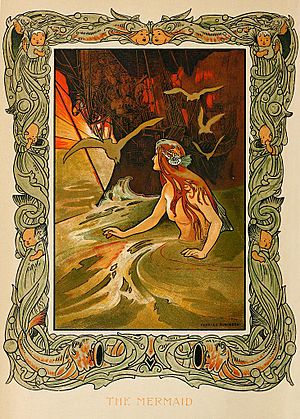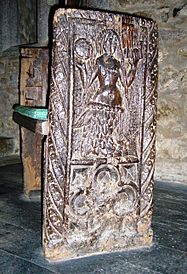Mermaid facts for kids
A mermaid is a make-believe creature from mythology. They have the head and upper body of a human woman, but the tail of a fish. Mermaids usually live in the water. Sometimes, people say they come out and sit on rocks near the sea.
Contents
What is a Mermaid?
The word "mermaid" comes from two old English words. "Mere" means "sea," and "maid" means "woman." So, a mermaid is a "sea woman." A male mermaid is called a merman.
Mermaids often appear in old stories. Some tales say they sing beautiful songs to people. These songs can make sailors forget what they are doing. This might cause ships to crash or people to fall overboard. Other stories say mermaids try to save drowning people. But they might accidentally pull them underwater. Some legends even say mermaids take humans to their underwater homes.
Mermaids are sometimes mixed up with sirens from Greek mythology. Sirens were often shown as bird-like creatures. But later, they were sometimes seen as having fish tails, like mermaids.
Mermaid Stories Through History
People have told stories about mermaids for a very long time. These tales come from many different parts of the world.
Ancient Times
The first known mermaid stories come from Assyria, around 1000 BC. One story is about a goddess named Atargatis. She accidentally hurt a shepherd she loved. She was so sad that she jumped into a lake. She wanted to become a fish to hide her beauty. But the water would not let her beauty be hidden. So, she turned into a mermaid instead.
Another old story is from Greece. It says that Alexander the Great's sister became a mermaid after she died. She lived in the Aegean Sea. When she saw a ship, she would ask the sailors one question: "Is King Alexander alive?" If they answered correctly, "He lives and reigns and conquers the world," she would make the sea calm. If they gave any other answer, she would get angry and cause a storm.
Tales from the Arabian Nights
The famous book One Thousand and One Nights has stories about "Sea People." One tale is about Djullanar the Sea-girl. These sea people are very much like humans. The main difference is that they can breathe and live underwater. They can also have children with humans from the land. These children can also live underwater.
Mermaids in the British Isles
In British folklore, mermaids were often seen as a sign of bad luck. Some old songs tell of mermaids warning ships that they would sink. They were also thought to bring bad weather.
Some stories describe mermaids as very large. They could even swim up rivers into freshwater lakes. One tale tells of a man who tried to save a woman he thought was drowning. His servant stopped him, saying it was a mermaid. The mermaid then yelled that she would have killed him if not for his servant.
However, not all mermaid stories were scary. Sometimes, mermaids were kind. They might even teach humans how to cure diseases. Mermen were often thought to be wilder and not interested in humans.
People Claim to See Mermaids
Some people say they have seen mermaids, both alive and dead. These sightings have been reported in places like Java and British Columbia, Canada.
In 2009, a town in Israel called Kiryat Yam offered a big prize. They said they would give $1 million to anyone who could prove mermaids lived off their coast. This was after many people claimed to see a mermaid. They said it leaped out of the water like a dolphin and did tricks. So far, no one has won the prize.
Mermaids in Art and Stories
Mermaids have inspired many artists and writers.
A famous painting called A Mermaid was made by John William Waterhouse. It was painted between 1895 and 1905. This painting was lost for a while but was found again in the 1970s.
One of the most famous mermaid stories is Hans Christian Andersen's fairy tale The Little Mermaid. He wrote it in 1836. This story has been translated into many languages around the world.
Mermaids also appear in music. Felix Mendelssohn wrote music about mermaids in his Fair Melusina. The three "Rhine daughters" in Richard Wagner's opera Der Ring des Nibelungen are also like mermaids.
Mermaids are popular in movies too. They appear in TV shows like Charmed. Animated movies include Disney's musical version of Andersen's tale. Another is Hayao Miyazaki's Ponyo.
Mermaids in Symbols
In heraldry, which is the study of coats of arms and symbols, mermaids are often shown. They usually hold a comb or a mirror. This makes them seem a bit vain.
The official Coat of arms of Warsaw, a city in Poland, has a mermaid. This mermaid, called Syrenka, holds a shield and a sword. The city of Norfolk, Virginia in the USA also uses a mermaid as its symbol.
The personal coat of arms of Michaëlle Jean, who was Canada's Governor General, also features two mermaids.
Mermaid Hoaxes
In the 1800s, a showman named P. T. Barnum displayed something called the Fiji mermaid. This was a fake mermaid. It was made by sewing together parts of a monkey and a fish. Other people have made similar fakes. They often use paper-mâché or parts of dead animals. After the 2004 tsunami, pictures of these fake "mermaids" appeared online. People claimed they had washed up on beaches, but they were not real.
Sirenomelia: Mermaid Syndrome
Sirenomelia is a very rare medical condition. It is also called "mermaid syndrome." This happens when a baby is born with their legs joined together. It is as rare as conjoined twins. It affects about 1 in every 100,000 babies born alive. This condition can cause serious problems for the kidney and bladder. As of 2003, only about four people with this condition were known to have survived.
Mermaids in Thai Stories
In Thai folklore, there is a famous story called "Phra Abhai Manee." It features a beautiful mermaid named "Praphanpheloung." She is a lovely lady with a tail instead of legs. The story tells of a prince who was taken by a giantess. A merman helped the prince and his son escape. The story describes mermaids as very beautiful. They have long black hair and pale skin. They love to sing and swim under the moon. Their eyes can see well in the dark but are blurry in the sun. This story was written by a famous poet named "Sunthornphu." Because the story takes place near the shore, statues of the characters, including the mermaid, are placed in Rayong, Thailand.
Mermaids in Pop Culture
Mermaids are popular characters in many modern movies. These include Splash and Aquamarine.
Related pages
Images for kids
-
Suvannamaccha and Hanuman, mural at Wat Phra Kaew, Bangkok.
-
A stone coat of arms in Santo Domingo church (Pontevedra, Galicia), 16th century.
-
Mermaid in Fefiñans Manor house (Cambados, Galicia), 16th century.
-
Portuguese Baroque stonework in Póvoa de Varzim Matriz Church (1743–1757)
-
Fountain depicting a mermaid playing a guitar, located in the Museum of the City of Mexico (17th century)
-
A stone coat of arms in (Mugardos, Galicia), 18th century
-
The Little Mermaid's Sisters by Anne Anderson (circa 1910)
-
Mermaid statue in Nuuk, Greenland
See also
 In Spanish: Sirena para niños
In Spanish: Sirena para niños
















